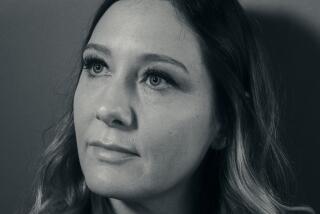THE GLAMOUR, AT LAST, FOR ‘COUSIN’ DIRECTOR
- Share via
“I’ve always been a fierce chauvinist about Canada,” said Sandy Wilson. “But having now been to L.A. and seen the opportunities, I have a lot more sympathy for those Canadians who’ve come here to work.”
Wilson, the slight Canadian film maker whose first feature, “My American Cousin,” has earned her so many bouquets from the critics, used to sit in her dingy editing room in Vancouver putting her picture together and dreaming--”I’d thought this was supposed to be a glamorous business.”
Just one week in Los Angeles, overseeing the opening of her movie here, showed her that, now and again, it still can be.
“I’ve finally seen the other side of the coin, the bright, flashy side of the film business, and I have to tell you I’ve loved it. It may have nothing to do with film making, but it’s great fun,” she said the other morning.
“In Canada we’re so slow and cautious. Here things happen much more quickly. I need that--at my age I haven’t got time to waste.”
In fact, Sandy Wilson has time (she’s 38) and, it would seem, talent too. And people who would hardly give her the time of day two years ago now take her calls immediately and listen when she talks.
One good movie--that’s all it takes. “My American Cousin,” with its six Canadian Genie awards (including best picture, best direction, best screenplay), has proved to be that movie.
“Now,” she said, “it no longer seems to be a question of ‘Are you moving to Los Angeles?’ but ‘When are you moving to Los Angeles?’ ”
Her autobiographical “My American Cousin” is about a lonely 12-year-old on a ranch in British Columbia whose diary starts: “Nothing ever happens. . . . “ But one day something does. A flashy young American cousin rolls into town with his red Cadillac convertible. The 12-year-old is captivated.
Wilson, who had made documentaries for the National Film Board of Canada, determined to make a feature about the incident--to recall in loving detail those days when to her, living in the Okanagan Valley, everything about America seemed fabulous. And the arrival of her cousin brought real glamour into her life.
How to raise the financing?
“Everyone said the same thing,” recalled Wilson. “ ‘Nothing ever happens in the script.’ I got turndowns from everybody I talked to.”
Then someone put her in touch with a group of wealthy Canadians living in the Cayman Islands. She flew there and talked to them.
“They would have come up with the money,” she said, “but they wanted total control and I said no.”
Eventually the movie was financed by producer Peter O’Brian, Telefilm Canada, a film development firm, and the Canadian Broadcasting Corp.--”though there was some opposition to the idea of my writing, producing and directing. Rightly so, I now feel; that’s too much for one person.”
The prospect of directing a feature worried her not at all, it seemed.
“I knew I could do it,” she said, “and I operate well on the idea of vengeance, of I’ll-show-you. I had a commitment to the story bordering on obsession. I also had a very good crew who helped me all the way.”
Originally there was a narration at the end of the movie explaining that the real Butch, the fabulous cousin, was later killed in a car crash when he was 22. But on reflection Wilson took it out.
“It just didn’t fit,” she said.
“What’s strange is that when the film was finished, I found that Butch had become a fictitious character to me; I felt he was someone I’d created for the film. It wasn’t until I showed it to his parents at the screening in Seattle that I was reminded forcibly what a real person he’d been.”
She still goes back to the scenic Okanagan Valley in British Columbia whenever she can.
“To me now it has the magic of childhood instead of the boredom,” she said. “Still, nothing happens there, of course. But now I can walk away. . . .”
More to Read
Only good movies
Get the Indie Focus newsletter, Mark Olsen's weekly guide to the world of cinema.
You may occasionally receive promotional content from the Los Angeles Times.









